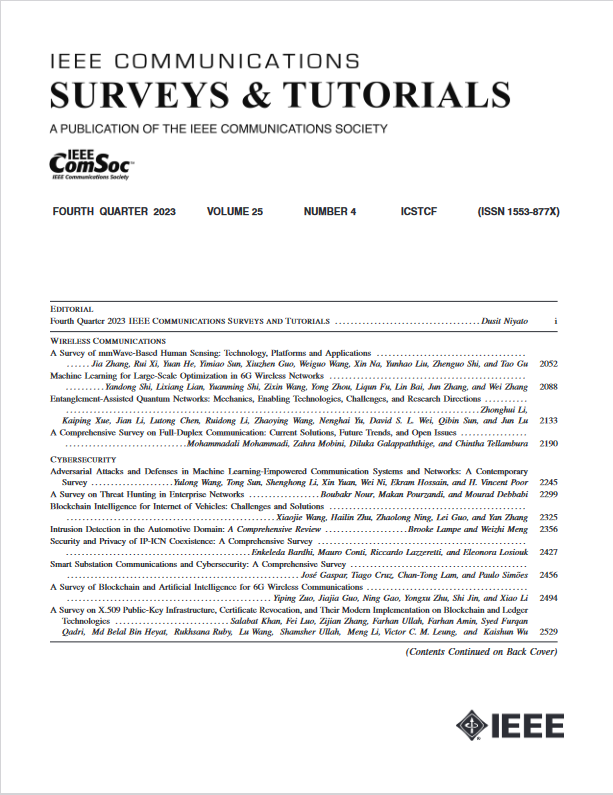后向散射通信的编码技术——当代综述
IF 34.4
1区 计算机科学
Q1 COMPUTER SCIENCE, INFORMATION SYSTEMS
引用次数: 14
摘要
反向散射通信(BackCom)网络实现了无源/无电池的物联网设备,提供了可靠的大规模连接,同时确保了自我可持续性、低维护和低成本。有效的信道编码和解码算法是实现这些目标所必需的。然而,尚未提供一份关于BackCom网络此类技术的全面调查/审查文件。本文旨在填补这一空白。由于标签的计算资源有限,传统的编码技术可能不适合它们。我们首先描述了BackCom的基本原理、信道代码及其相关设计参数,以及通用通信网络的代码。我们解决了BackCom的限制、要求和渠道特征。由于传统编码可能无法无缝转移到BackCom领域,我们确定了潜在的BackCom编码技术和多址方案。我们进一步强调了解决代码实现复杂性和可靠性的潜在方法。最后,我们讨论了悬而未决的问题、挑战和未来潜在的研究方向。本文章由计算机程序翻译,如有差异,请以英文原文为准。
Coding Techniques for Backscatter Communications—A Contemporary Survey
Backscatter communication (BackCom) networks enable passive/battery-free Internet-of-Thing devices, providing reliable, massive connectivity while ensuring self-sustainability, low maintenance, and low costs. Effective channel codes and decoding algorithms are necessary to achieve these objectives. However, a comprehensive survey/review paper on such techniques for BackCom networks has not been available. This paper aims to fill this gap. Because tags have limited computational resources, traditional coding techniques may not suit them. We first describe the basics of BackCom, channel codes and their relevant design parameters, and codes for general communication networks. We address the BackCom limitations, requirements, and channel characteristics. As conventional codes may not seamlessly move to the BackCom arena, we identify the potential BackCom coding techniques and multiple access schemes. We further highlight potential approaches for addressing code implementation complexity and reliability. Finally, we discuss open issues, challenges, and potential future research directions.
求助全文
通过发布文献求助,成功后即可免费获取论文全文。
去求助
来源期刊

IEEE Communications Surveys and Tutorials
COMPUTER SCIENCE, INFORMATION SYSTEMS-TELECOMMUNICATIONS
CiteScore
80.20
自引率
2.50%
发文量
84
审稿时长
6 months
期刊介绍:
IEEE Communications Surveys & Tutorials is an online journal published by the IEEE Communications Society for tutorials and surveys covering all aspects of the communications field. Telecommunications technology is progressing at a rapid pace, and the IEEE Communications Society is committed to providing researchers and other professionals the information and tools to stay abreast. IEEE Communications Surveys and Tutorials focuses on integrating and adding understanding to the existing literature on communications, putting results in context. Whether searching for in-depth information about a familiar area or an introduction into a new area, IEEE Communications Surveys & Tutorials aims to be the premier source of peer-reviewed, comprehensive tutorials and surveys, and pointers to further sources. IEEE Communications Surveys & Tutorials publishes only articles exclusively written for IEEE Communications Surveys & Tutorials and go through a rigorous review process before their publication in the quarterly issues.
A tutorial article in the IEEE Communications Surveys & Tutorials should be designed to help the reader to become familiar with and learn something specific about a chosen topic. In contrast, the term survey, as applied here, is defined to mean a survey of the literature. A survey article in IEEE Communications Surveys & Tutorials should provide a comprehensive review of developments in a selected area, covering its development from its inception to its current state and beyond, and illustrating its development through liberal citations from the literature. Both tutorials and surveys should be tutorial in nature and should be written in a style comprehensible to readers outside the specialty of the article.
 求助内容:
求助内容: 应助结果提醒方式:
应助结果提醒方式:


